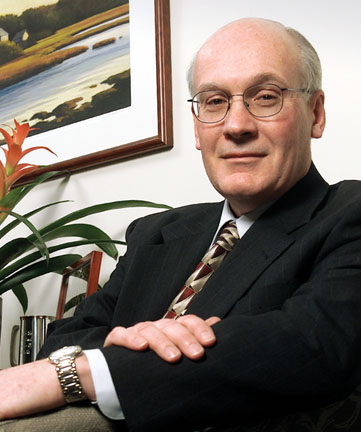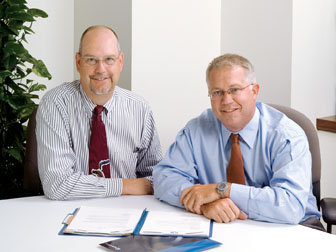
Richard W. Brewer is President and CEO of ProMutual Group.
Conservative, agent-focused carrier expands beyond its Massachusetts origins
By Phil Zinkewicz
Of all the liability lines of insurance—product liability, pollution liability, employment practices liability—probably the one that has stirred the most emotions among the public in recent years is medical malpractice liability. In product liability cases, the debate is usually over whether a product is defective vs. whether it was misused, and money is at the bottom line. Similarly, in pollution liability and employment practices liability, what is at issue is how much and who will pay in order to right the wrong that has allegedly occurred.

|
Richard W. Brewer is President and CEO of ProMutual Group. |
Money is at the bottom of medical malpractice suits as well, but the emotional element stems from the fact that the wrong is usually alleged to have been committed by a person or persons in the medical community. The very people and institutions who are supposed to be there to help us—the doctors, nurses, hospitals, nursing homes, etc.—are being accused of some sort of misconduct leading to injury to or death of the patient.
Juries are usually more than sympathetic to people who have suffered injuries while under the care of medical professionals. Perhaps that’s why jury awards have been increasing in recent years in medical malpractice cases. Jury Verdict Research of Horsham, Pennsylvania, says that the median award jumped 40% in 1998, from $500,000 to $700,000. There was no change from 1998 to 1999. Then in 2000, the median skyrocketed 43%, to $1 million. Today, jury awards of $1 million or more are considered the norm.
The severity of jury awards has caused many malpractice insurers to rethink their participation in the marketplace. Many have seriously curtailed their medical malpractice underwriting, and it was only a few years ago that The St. Paul, at one time the leading medical malpractice insurer, pulled out of the business altogether. Many of those that stayed in the business raised rates to such levels that some doctors have exited their professions and others have taken to the streets to protest what they claim are crippling medical malpractice premiums.
So far, lawmakers on both the state and federal levels have made little progress in bringing stability to the medical malpractice arena. While efforts to introduce caps on medical malpractice awards have succeeded in some states, no significant reforms have been enacted to any large degree. Likewise on the national level, to date no med mal reform has emerged from Congress.
This isn’t the first time that medical malpractice insurance reached crisis proportions. In the 1970s, malpractice insurance was almost exclusively provided by large national carriers. These companies were financially strong; however, when awards began to grow larger and companies began to experience large losses, they abandoned the medical malpractice market.
Unable to obtain malpractice insur-ance at any cost, groups of physicians organized with the support of state medical societies, and doctor-directed insurance companies were born.
ProMutual Group evolved into one of those companies and, according to its chairman, Barry M. Manuel, the goal of the company was to “never again” have the fate of medical practices in the hands of companies with little commitment to health care. For a time, in the late 1980s, rates for physicians and hospitals stabilized. But the 1990s brought on increasing numbers of malpractice lawsuits and increasing jury awards while, because of a burgeoning stock market, investment earnings caused insurers to seek premium dollars to invest and to underprice their products. Many malpractice insurers fell by the wayside when this “cash flow” scenario exploded during the late 1990s and the turn of this century. But ProMutual Group continued on. Insurers, ProMutual Group among them, came to the harsh realization that premiums needed to increase in order to stabilize the marketplace.
Richard W. Brewer, president and CEO of ProMutual Group, describes the current scenario this way: “The past few years have been a time of financial instability and rising rates, what many in the industry have called a ‘perfect storm.’ This resulted from the convergence of low premiums, intense competition, rapidly rising claim frequency and severity, the economic impact of 9/11, and modest investment returns.
“Over the past three years, we have implemented rate increases in every state where we do business in order to bring rates in line with loss experience,” he continues. “We are just now beginning to see the benefits of these past changes. In 2003, rates became more adequate. One of our key ratios, the combined ratio, that compares premiums to claim and operating expenses, improved and we expect it to improve more significantly in 2004. Toward this goal, we are pursuing a number of initiatives designed to write additional quality business. ProMutual Group is no longer a one-state operation.”
Initially, ProMutual Group wrote business only in Massachusetts but has branched out and today writes in all the New England states and in New Jersey.
“We have been able to grow substantially while maintaining the integrity of our underwriting and pricing standards,” says Brewer. “This has permitted us to serve the needs of nearly 16,000 policyholders. Today, we are the largest malpractice insurance writer in Massachusetts, the second largest in Connecticut, Maine, New Hampshire, Rhode Island and Vermont, and the third largest writer in New Jersey.”
But what about what many perceive as the oncoming new soft market? Will ProMutual Group be able to maintain its present pricing structure in the face of competition from “new players” who are eager to take advantage of a more favorable pricing environment and drive down premium levels once again? Brewer answers in the affirmative on that last question.
“The market in the malpractice arena hasn’t softened yet to the extent that it has in other lines. But if and when it does, we will have to have ‘strong stomachs’ and resist cash flow underwriting even in the face of losing business.”
However, Brewer maintains that ProMutual Group has a good deal more going for it than merely pricing. “We have structured ourselves with a team of professionals who work collaboratively to make certain we are taking on the right risks and minimizing the prospects of losses through sound risk management,” he says.
That team consists of Mike Kubik, vice president of marketing; Gregg Hanson, senior vice president of underwriting; Al Afonso, vice president of claims; and Maureen Mondor, vice president of risk management.
 |
 |
Gregg L. Hanson (left), Senior Vice President/Underwriting, and Michael R. Kubik, Vice President/Marketing, work closely to provide service to agents and policyholders. |
Almor M. Afonso (left), Vice President/Claims, and Maureen C. Mondor, Vice President/ Risk Management, provide policyholders with best-in-class service. |
“We’re doing well right now,” says Kubik. “But our goal is to maintain profitability so that we are a strong and stable carrier when the market softens, as it inevitably will. We will achieve this by continuing to offer value-added services to our clients and to our distribution force—the independent agent. We choose our agents carefully. In the beginning, we had two or three agents working with us. Today, we have an average of 20 agents for each state in which we operate. Each specializes in medical malpractice. Thus, we work with agents who know how to work with the health care community, hospitals, as well as doctors. What we as a company offer our agents is a market that is financially stable and committed to the malpractice insurance marketplace. We have knowledge of the health care industry; we provide outstanding claims and risk management services; and we have the expertise to grow and succeed in the business.”
Hanson, who is in charge of underwriting, says that the proper pricing of the malpractice insurance product is essential to a company’s success. “Proper rates are needed to make profits, whether the market is hard or soft,” he says. “In setting those rates, we rely on the information provided to us by our other departments that have their ‘eyes on the field.’ We have to know what claims are costing us money. We listen to our risk management department, members of which visit hospitals and doctors’ offices to examine their procedures. We rely on our marketing department to tell us what the competition is doing. We have a formalized process for large accounts, where our entire team—marketing, claims, risk management and underwriting—becomes involved. We have frequent meetings with each other and conference calls.”
Afonso is in charge of the claims handling and claims information gathering part of the team effort. “Severity is a major problem in medical malpractice insurance,” he says. “Fortunately, we win about 90% of our cases, but the other 10% represents a problem. Still, we close about 78% of our cases without indemnity payments. We provide other departments at ProMutual Group with the information we gather in our claims handling capacity to assist them in what they do.”
What Maureen Mondor does is provide the risk management expertise for the company. “It really is a team effort,” she says. “From marketing, we learn where the industry is going. From claims, we learn where we should apply our risk management tools. We work with the underwriting department to mitigate the potential for loss.
“No physician wants to face the stress and disruption of a malpractice claim,” she adds. “That is why the risk management department works directly with physicians to help them identify the areas of actual or potential risk and to suggest the appropriate technique or combination of techniques for avoiding loss exposures.”
The risk management tools employed by Mondor’s department include visits to physician groups’ offices. “We do appraisals and advise our underwriting department as to what needs to be done to lessen the possibility of a claim. Our appraisals also help the underwriting department in setting a proper premium. We are very specific in our appraisals. If we visit a pediatrician’s office, we compare that office to other pediatricians. We do the same thing with hospitals, appraising their ER and OR operations to see where the claims might come. We also work through specialty medical societies to determine the most up-to-date protocols in certain procedures. We analyze that material and present it to our claims and underwriting departments,” she says.
Brewer says that it is this team effort that makes ProMutual Group stand out from other malpractice insurers.
“We have made great strides in recovering from the adverse conditions of the last few years and this has reinforced the importance of our financial strength. However, we still have a lot of work to do. The next year will be critical. Actions we will put into place will position ProMutual Group to respond better to the needs of policyholders. We believe that, through our team effort, we can provide the value-added services they want and need.” *
For more information:
ProMutual Group
Web site: www.promutualgroup.com